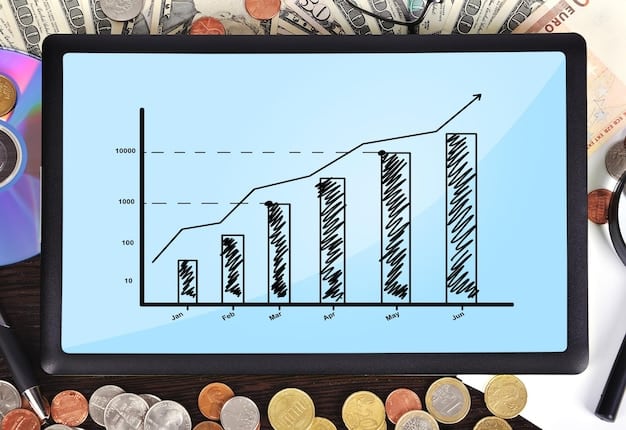ESPP Advantages: Leveraging a 15% Discount for Financial Gains

Employee Stock Purchase Plans (ESPPs) offer employees a chance to buy company stock at a discounted rate, often 15%, providing a path to long-term financial growth by aligning employee and company success.
Unlock your financial potential with Employee Stock Purchase Plans (ESPPs): How to Leverage a 15% Discount for Long-Term Financial Gains. This guide will show you how to maximize the benefits of this valuable employee benefit.
Understanding Employee Stock Purchase Plans (ESPPs)
Employee Stock Purchase Plans (ESPPs) are a fantastic benefit offered by many companies. They allow employees to purchase company stock, typically at a discount, making it an attractive way to invest.
These plans encourage employee ownership and alignment with the company’s success. Let’s dive into the specifics of how ESPPs work and why they’re beneficial.
How ESPPs Work
ESPPs usually work by allowing employees to contribute a portion of their paycheck, after tax, into an account over a defined period, such as a quarter or a year. At the end of this period, the accumulated funds are used to purchase company stock at a discounted price.
Key Components of an ESPP
Understanding the key components is crucial to making informed decisions about participating in an ESPP.
- Offering Period: The duration during which you can contribute to the ESPP.
- Purchase Date: The date on which your accumulated funds are used to buy company stock.
- Look-Back Provision: Some ESPPs have a “look-back” provision, which allows you to purchase the stock at the lower of the stock price at the beginning or end of the offering period.
- Discount: The percentage discount offered on the stock price, typically up to 15%.
ESPPs can be a valuable tool for building long-term wealth, but it’s essential to understand how these plans work and their potential benefits and risks.

The Benefits of Participating in an ESPP
Participating in an Employee Stock Purchase Plan comes with several potential advantages. These plans offer a way to invest in your company’s future while also benefiting financially.
Here’s a closer look at some of the key benefits you could experience.
Immediate Discount
One of the most attractive features of an ESPP is the immediate discount on the stock price. A 15% discount means you’re essentially buying stock at a reduced rate compared to the market price.
Potential for Capital Appreciation
If your company’s stock performs well, you could see significant capital appreciation. This means your investment could grow substantially over time, leading to a higher return.
- Long-Term Growth: Holding the stock for the long term can lead to substantial gains.
- Dividend Income: Some companies pay dividends, providing an additional income stream.
- Compounding Returns: Reinvesting dividends can further enhance your returns.
While there are risks involved, the potential rewards of participating in an ESPP can be substantial, making it a compelling option for many employees.
Understanding the Risks and Considerations
While ESPPs offer enticing benefits, it’s crucial to be aware of the potential risks and considerations before participating. Understanding these can help you make informed decisions.
Let’s explore the downsides and important factors to consider.
Concentration Risk
Investing heavily in your company’s stock can lead to concentration risk. If the company performs poorly, both your job and investment could be at risk.
Tax Implications
ESPPs have specific tax implications that you need to understand. The discount you receive is generally considered taxable income.
Factors to Consider
Evaluating your financial situation and risk tolerance is key to determining if an ESPP is right for you.
- Financial Stability: Ensure you have a stable financial foundation before investing.
- Risk Tolerance: Assess how much risk you’re comfortable taking.
- Diversification: Consider diversifying your portfolio to mitigate risk.
By carefully considering these risks and factors, you can decide whether an ESPP aligns with your financial goals and risk tolerance.

Strategies for Maximizing ESPP Benefits
To get the most out of your Employee Stock Purchase Plan, it’s essential to have a strategy. Maximizing your benefits involves understanding the plan’s features and making smart decisions.
Here are some strategies to help you make the most of your ESPP.
Contribute the Maximum Amount
Contributing the maximum amount allowed by the plan can significantly increase your potential returns, especially if the stock performs well.
Hold or Sell?
Deciding when to hold or sell your stock is a critical decision. Your investment strategy should align with your financial goals and risk tolerance.
- Short-Term Gains: Selling immediately can lock in the discount as profit.
- Long-Term Growth: Holding the stock can lead to further appreciation if the company performs well.
- Tax Efficiency: Consider the tax implications when deciding when to sell.
By implementing these strategies, you can optimize your ESPP benefits and work towards achieving your financial goals.
Tax Implications of ESPPs
Understanding the tax implications of Employee Stock Purchase Plans is crucial for making informed financial decisions. The tax rules surrounding ESPPs can be complex.
Let’s break down the key tax considerations.
Disqualifying Dispositions
If you sell your ESPP stock within two years of the grant date or one year of the purchase date, it’s considered a disqualifying disposition. The difference between the market price at purchase and the discounted price is taxed as ordinary income.
Qualifying Dispositions
If you hold the stock for at least two years from the grant date and one year from the purchase date, it’s considered a qualifying disposition. In this case, the discount is still taxed as ordinary income, but any additional profit is taxed at the long-term capital gains rate, which is typically lower.
Tax Reporting
Accurately reporting your ESPP transactions on your tax return is essential. Keep detailed records of your purchases and sales to ensure compliance.
A general understanding of ESPP tax rules is essential to ensure you’re making the most of this employee benefit and avoiding unexpected tax consequences.
ESPPs vs. Other Employee Benefits
When considering your employee benefits, it’s helpful to compare ESPPs with other options. Understanding the differences can help you make the best choices for your financial situation.
Let’s compare ESPPs to other common benefits like 401(k)s and stock options.
ESPPs vs. 401(k)s
While ESPPs allow you to purchase company stock at a discount, 401(k)s are retirement savings plans that offer tax advantages.
ESPPs vs. Stock Options
Stock options give you the right to purchase company stock at a set price in the future, while ESPPs involve purchasing stock at a discounted price immediately.
- Investment Mix: Diversify your investment portfolio across multiple asset classes.
- Financial Goals: Align your benefits with your long-term financial goals.
By understanding the unique features of each benefit, you can create a well-rounded financial plan that aligns with your needs and goals.
| Key Point | Brief Description |
|---|---|
| 💰 15% Discount | Buy company stock at a reduced price. |
| 📈 Capital Appreciation | Potential for stock value to increase over time. |
| ⚠️ Concentration Risk | Investing heavily in one company’s stock. |
| 💼 Financial Strategy | Align ESPP participation with your financial goals. |
Frequently Asked Questions (FAQ)
▼
Most ESPPs offer a discount of up to 15% on the fair market value of the company’s stock. This discount can provide an immediate return on your investment.
▼
The purchase frequency varies by company but is typically quarterly or semi-annually. Check your plan documents for the specific purchase dates and contribution periods.
▼
If you leave the company before the purchase date, your contributions are usually returned to you. The terms of your ESPP will outline the specific procedure.
▼
No, ESPP contributions are not tax-deductible. However, the discount you receive may be subject to income tax, and capital gains taxes may apply when you sell the stock.
▼
Yes, you can generally participate in both an ESPP and a 401(k). Both plans serve different financial goals, with the ESPP focused on company stock purchase and the 401(k) on retirement savings.
Conclusion
Employee Stock Purchase Plans (ESPPs): How to Leverage a 15% Discount for Long-Term Financial Gains offer a valuable opportunity for employees to invest in their company’s success. By understanding the benefits, risks, and tax implications, employees can make informed decisions to maximize their financial gains and align their interests with the company’s growth.





